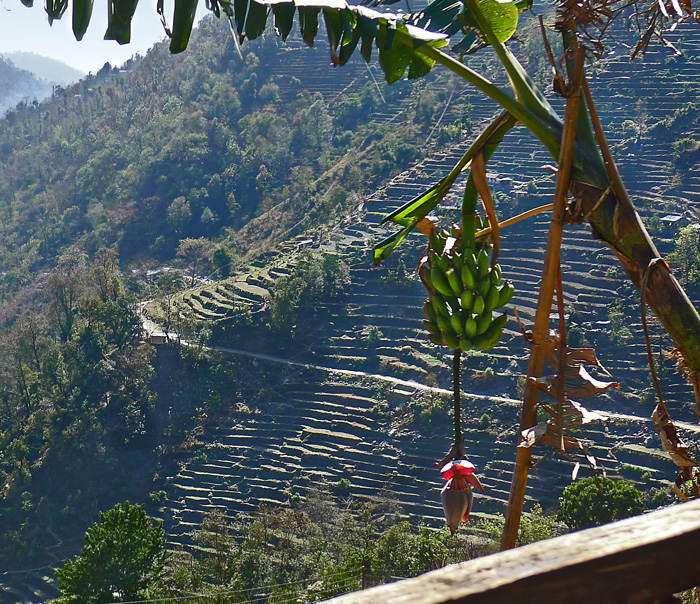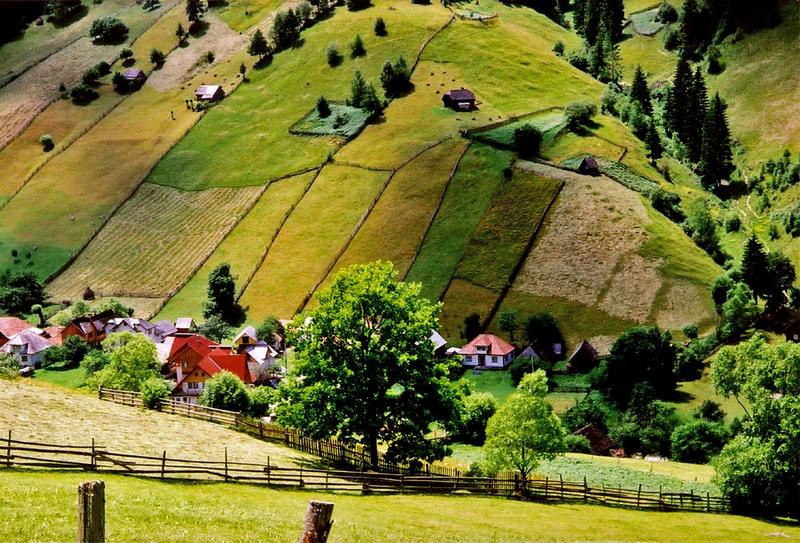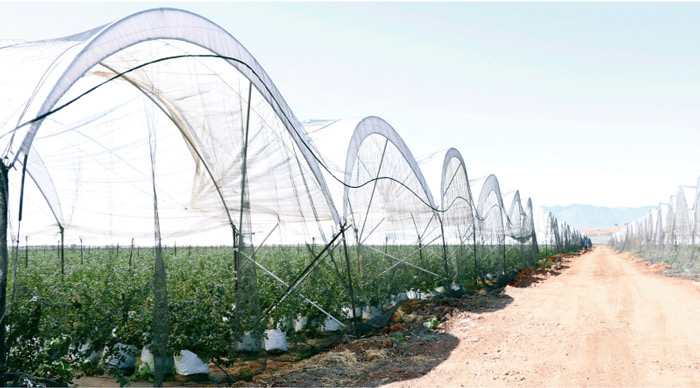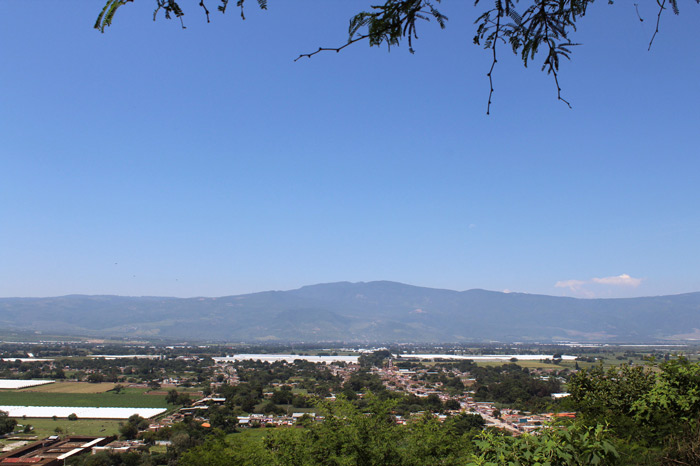Hole in the Clouds
Jul 6, 2011
 The valleys and lowermost hillsides of Nepal are subtropical; the crops grown there include tea and coffee and these banana trees. If a sturdy trekker were determined to leave the subtropics behind, he or she could walk straight uphill from here into patches of spring snow in a few hours, and into the glacial icefields of the high Himalaya in a few days.
The valleys and lowermost hillsides of Nepal are subtropical; the crops grown there include tea and coffee and these banana trees. If a sturdy trekker were determined to leave the subtropics behind, he or she could walk straight uphill from here into patches of spring snow in a few hours, and into the glacial icefields of the high Himalaya in a few days.
Global warming is spreading up the mountainsides. Nepalis hope they have figured out a way to make money on climate change; the increasing heat in the air that has reduced productivity of tea plantations in India seems to have permitted tea cultivation higher than ever before on Nepalese hillsides. Not all the new plantings have thrived–the air is thinner in the high mountains, and the soil is rocky and poor. But fine tea is coming out of Nepal these days, from slopes about a mile higher than the bananas shown here.
In the long run, of course, tea won't save Nepal. As the glaciers shrivel in the high mountains and a scanty winter snowpack produces less and less spring runoff for the rivers of the subcontinent, people will have a hard time growing much of anything. Huge thirsty cities downstream are already beginning to compete for water with peasants struggling to irrigate the tiny terraces they have clawed into the mountainsides of Nepal.
Well. Maybe somebody will think of something.
landscape
mountains
Nepal
farm
trekking
bananas
agriculture
valley
Jun 4, 2012
 "Somewhere in Transylvania," according to the photographer, who offers up only two facts about himself by way of identification: he lives in the city of Arad in western Romania, and he likes Johnny Cash and Frank Sinatra.
"Somewhere in Transylvania," according to the photographer, who offers up only two facts about himself by way of identification: he lives in the city of Arad in western Romania, and he likes Johnny Cash and Frank Sinatra.
Romania
landscape
birdseye view
agriculture
pastoral
Transylvania
Jan 12, 2018
 It's dark, chilly midwinter here in the Pacific Northwest, but the supermarket shelves are piled high with sweet summer raspberries and blueberries and blackberries. All those berries can't be coming from around here–blackberries are notorious weeds hereabouts and other berries grow readily, but the plants are dormant in the winter and yield fruit only in the summer.
It's dark, chilly midwinter here in the Pacific Northwest, but the supermarket shelves are piled high with sweet summer raspberries and blueberries and blackberries. All those berries can't be coming from around here–blackberries are notorious weeds hereabouts and other berries grow readily, but the plants are dormant in the winter and yield fruit only in the summer.
Parts of Chile are climatically similar, though of course with the seasons reversed, and so Chilean berry-growers started loading their fruit on big cargo planes and flying it all the way up here in the wintertime, to be sold at very high prices reflecting the cost of air transport.
Nowadays, however, Chilean berries are all used for juice; the air-shipping premium was just too costly to make them competitive in the fresh-berry market. The huge North American market for fresh berries–which is booming at the moment, thanks to crazes for antioxidants and smoothies–depends on locally grown fruit in the summertime and then, for literally every other month of the year, on berries grown in greenhouse-like plastic tunnels high in the mountains of the Mexican state of Jalisco.
If chilled immediately, fresh berries can have a shelf life of more than a month, which is plenty of time for refrigerated trucks to carry them from their greenhouse tunnels–tuneles–in central Mexico to virtually any grocery store in the U.S.
The high-altitude berry farms, a mile or more above sea level and cooled a bit by Pacific breezes, don't get as searingly hot in the summertime as the rest of Mexico. The semi-shade in the plastic tunnels further blunts the subtropical sun and also slows evaporation, saving water.
But even with all these adaptations, berry bushes and canes in Mexico don't behave the same way they do in, say, Oregon or New Jersey. In Jalisco, the plants rest in the summertime and produce fruit in cooler months–which is just when the North American market has particular call for them.
The tunnels do yield less fruit per acre, but Mexican growers are okay with that; their overall costs are still low. In fact, in the last ten years they have converted so much land to blueberries and raspberries and blackberries that Mexican fresh-berry-production has become a billion-dollar industry.
Mexicans, however, still don't really care for the taste.

Mexico
fruit
agriculture
 The valleys and lowermost hillsides of Nepal are subtropical; the crops grown there include tea and coffee and these banana trees. If a sturdy trekker were determined to leave the subtropics behind, he or she could walk straight uphill from here into patches of spring snow in a few hours, and into the glacial icefields of the high Himalaya in a few days.
The valleys and lowermost hillsides of Nepal are subtropical; the crops grown there include tea and coffee and these banana trees. If a sturdy trekker were determined to leave the subtropics behind, he or she could walk straight uphill from here into patches of spring snow in a few hours, and into the glacial icefields of the high Himalaya in a few days. "Somewhere in Transylvania," according to the photographer, who offers up only two facts about himself by way of identification: he lives in the city of Arad in western Romania, and he likes Johnny Cash and Frank Sinatra.
"Somewhere in Transylvania," according to the photographer, who offers up only two facts about himself by way of identification: he lives in the city of Arad in western Romania, and he likes Johnny Cash and Frank Sinatra. It's dark, chilly midwinter here in the Pacific Northwest, but the supermarket shelves are piled high with sweet summer raspberries and blueberries and blackberries. All those berries can't be coming from around here–blackberries are notorious weeds hereabouts and other berries grow readily, but the plants are dormant in the winter and yield fruit only in the summer.
It's dark, chilly midwinter here in the Pacific Northwest, but the supermarket shelves are piled high with sweet summer raspberries and blueberries and blackberries. All those berries can't be coming from around here–blackberries are notorious weeds hereabouts and other berries grow readily, but the plants are dormant in the winter and yield fruit only in the summer.